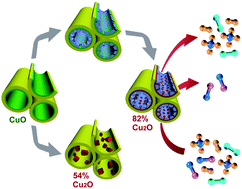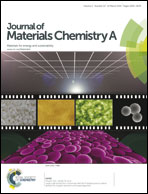Constructing a confined space in silica nanopores: an ideal platform for the formation and dispersion of cuprous sites†
Abstract
Due to their versatility, nontoxicity, and low cost, much attention has been paid to the fabrication of Cu(I) sites on various supports. High-temperature autoreduction is a widely used method for selective conversion of supported Cu(II) to Cu(I). However, aggregation of copper species usually takes place during autoreduction, which seriously decreases the yield of Cu(I) and compromises the activity of resultant materials. In the present study, a strategy was developed for the effective formation and dispersion of Cu(I) sites by constructing a confined space in silica nanopores, for the first time. A layer of porous silica is coated on the precursor (namely CuO-modified SBA-15) before autoreduction, and CuO is thus confined between original pore walls and newly formed silica layers. Owing to the energy barrier offered by the confined space, the dispersion degree of copper species after autoreduction is well improved. Furthermore, the yield of Cu(I) can reach ∼82% for the samples coated with silica, which is obviously higher than that for the sample without a silica layer (∼54%). More importantly, abundant pores with a uniform size of ∼2.5 nm are successfully generated on the silica layer under the direction of cetyltrimethylammonium bromide (CTAB). This endows the resultant materials with active sites highly accessible to guest molecules. The materials were also applied to the adsorption of CO by using π-complexation between CO and Cu(I) sites. The results show that these materials exhibit good performance for selective adsorption of CO from H2, CH4, and N2, which is apparently better than the material without a silica layer with regard to both capacity and selectivity.


 Please wait while we load your content...
Please wait while we load your content...